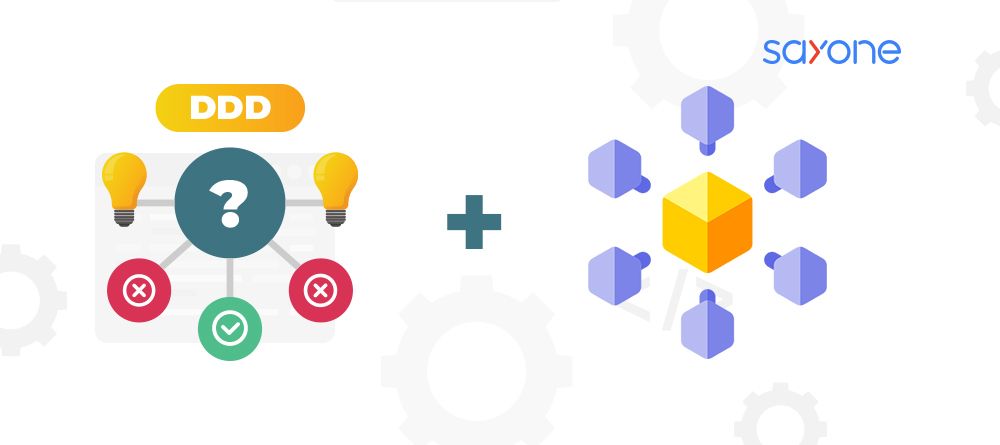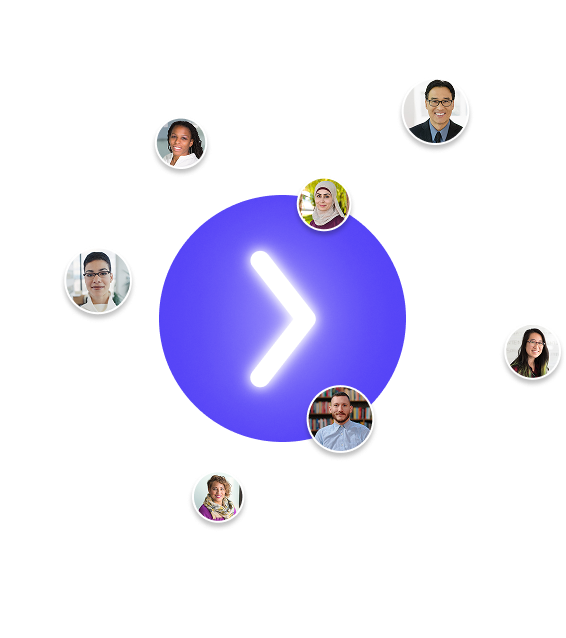
Subscribe to our Blog
We're committed to your privacy. SayOne uses the information you provide to us to contact you about our relevant content, products, and services. check out our privacy policy.

Sayone technologiesSeptember 12, 202310 min read

Generating table of contents...
At its core, Domain Driven Design (DDD) is a strategic approach focused on building complex software by connecting the technical details to an evolving model. The design emphasizes the domain, which represents the sphere of knowledge and activity around which the application logic revolves.
Software applications need to be agile, adaptable, and centered around the end user's needs. DDD offers a clear pathway for this by bridging the gap between technical and domain experts, ensuring that both understand and are aligned on the software's goals and functionalities.
This alignment proves crucial when shifting towards microservices. Microservices demand a deep understanding of the business domain to ensure that services are well-defined, isolated, and capable of independent evolution.
As companies strive to build resilient, scalable, and user-focused software, the principles of DDD play an essential role in guiding effective microservices architecture decisions.
This combination helps businesses to stay ahead, ensuring their software remains relevant and adaptable to changing requirements.
Domain-Driven Design (DDD) focuses on a system's main problems and primary goals, addressing complexities with clarity. At the heart of DDD lies the 'domain,' which is a software solution's sphere of knowledge and influence. This design approach aims to bridge the gap between technical experts and domain experts, ensuring that everyone speaks the same language, known as the 'Ubiquitous Language.' This common language is embedded in the codebase, making it both a tool for communication and a reflection of the software design.
Read more on Testing Microservices – A Complete Guide
In the context of microservices, understanding and applying these DDD principles can guide teams to design more focused and cohesive services. With a clear boundary established around each microservice, managing complex systems becomes more straightforward, and businesses can innovate more rapidly.
Checkout : Top 6 Microservices Trends to Take Note of in 2023
Domain Driven Design (DDD) brings a strategic perspective into software development by focusing on the core domain and its logic. Conversely, microservices emphasize breaking down applications into small, manageable, and independent services. When you marry DDD with microservices, you get a powerful combination.
By using DDD, businesses can dissect complex domains into more digestible sub-domains. These subdomains can then be transformed into individual microservices. This ensures that each microservice has a clear purpose and responsibility.
Checkout : Java Microservices Architecture - A Complete Guide
A key strength of microservices is their ability to function autonomously, ensuring rapid development and deployment cycles. DDD aids in achieving this autonomy.
When each microservice corresponds to a distinct domain or sub-domain, it minimizes dependencies, allowing them to evolve independently. This isolation is not just about functionality but also data.
Using DDD, each microservice manages its own data, thereby reducing data conflicts and simplifying data management.
By aligning DDD principles with microservices architecture, businesses can design modular and focused systems, making the journey of implementing microservices more strategic and purposeful.
Checkout 5 Microservices Examples: Amazon, Netflix, Uber, Spotify & Etsy
Domain-Driven Design (DDD) is a conceptually intensive design pattern, making it suitable only for systems complex enough to justify the additional planning effort. For simpler or smaller systems, other approaches like Test-Driven Development (TDD) or Behavior-Driven Development (BDD) may suffice. TDD is the quickest to implement, particularly when dealing with individual microservices or applications with only a few services.
At a larger scale, BDD can be utilized to verify overall system behavior through integration and acceptance tests. BDD is effective for low to medium complexity designs, but as complexity increases, maintaining the tests may become a bottleneck.
These three methods—DDD, TDD, and BDD—can also be combined, selecting the most appropriate approach for each phase of development. For example:
Domain Driven Design (DDD) offers patterns that can help teams understand and shape complex software projects. These patterns can significantly improve the design and structure when applied to microservices.
CQRS, or Command Query Responsibility Segregation, is a design pattern that differentiates between command and query operations. Separating these two distinct operations allows you to optimize each for its specific purpose.
In the context of microservices, this separation can be a game-changer. With it, you're able to distribute, scale, and adapt your system's components based on actual demand and behavior.
Event Sourcing stores every state change in your system as an individual event. Instead of just keeping the latest state, you maintain a log of all historical events. This approach ensures that data isn't lost and provides a reliable method to reconstruct the system state.
For Domain-Driven Design (DDD), Event Sourcing plays a pivotal role. DDD is all about focusing on the domain, and events are key domain elements. When combined, DDD and Event Sourcing allow for better system design, where the domain events dictate the state changes, leading to a more traceable and adaptable microservices architecture.
If you're considering the implementation of microservices, understanding the value of CQRS and Event Sourcing can provide clarity and direction in your design decisions. Their integration into DDD offers a structured, maintainable path toward scalable and adaptive systems.
While Domain Driven Design (DDD) offers a structured approach to building software, applying its principles to microservices architecture introduces intricacies. A prime challenge is the breaking down of a system into multiple bounded contexts. This requires keen domain knowledge and a clear delineation of business responsibilities. A misstep here can lead to unwieldy service dependencies.
Solutions:
Read More on Micro Frontends: What are they, and When to use them?
Some common challenges when implementing DDD for microservices include:
The dynamic nature of microservices demands attention to scalability and data consistency. With each microservice managing its own database, ensuring data integrity becomes challenging.
Solutions:
By addressing these challenges head-on and with strategic solutions, companies can navigate the complexities of DDD in the microservices landscape, ultimately benefiting from a more scalable and maintainable system.
Checkout Microservices vs Monolithic: Which to Choose ?
Understanding Domain-Driven Architecture for Microservices in 2025
The importance of understanding Domain Driven Design increases as we go deeper into the world of microservices architecture. To help you on your way, consider these important steps:
Conclusion
The Road Ahead for DDD and Microservices:
The evolution of software architecture has placed Domain Driven Design (DDD) and Microservices in the spotlight. As organizations shift towards a decentralized approach to system development, integrating DDD with Microservices promises more responsive, adaptable, and maintainable systems.
Key Points to Remember:
Recommendations for Successful Implementation:
Invest time in understanding the core concepts of DDD. Its principles guide how Microservices are designed and function together.
Communication is the key. Maintain clear communication channels between teams to ensure the essence of the domain doesn't get lost in translation.
Prioritize training. Ensure your team is well-versed with DDD concepts and Microservices best practices for smoother implementation.
By integrating DDD with Microservices, businesses can create systems that cater to current needs and are well-equipped for future challenges.
Considering a move towards microservices? SayOne Technologies offers Microservices development services; we stand ready to guide you in this transformation, ensuring that concepts like Domain Driven Design are aptly integrated into your design strategy.
Don't leave such crucial aspects to chance; opt for expertise.

We're committed to your privacy. SayOne uses the information you provide to us to contact you about our relevant content, products, and services. check out our privacy policy.

About Author
Fuelling Happiness.

We collaborate with visionary leaders on projects that focus on quality